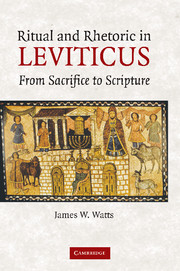Book contents
- Frontmatter
- Contents
- Abbreviations
- Preface
- Ritual and rhetoric in Leviticus
- 1 Introduction: Ritual Text and Ritual Interpretation
- 2 The Rhetoric of Ritual Instruction
- 3 The Rhetoric of Burnt Offerings
- 4 The Rhetoric of Sin, Guilt, and Ritual Offerings
- 5 The Rhetoric of Ritual Narrative
- 6 The Rhetoric of Atonement
- 7 The Rhetoric of Priesthood
- 8 The Rhetoric of Sacrifice
- 9 The Rhetoric of Scripture
- Bibliography
- Index of Biblical Citations
- Index of Other Ancient Literature
- Index of Authors
- Index of Subjects
9 - The Rhetoric of Scripture
Published online by Cambridge University Press: 22 July 2009
- Frontmatter
- Contents
- Abbreviations
- Preface
- Ritual and rhetoric in Leviticus
- 1 Introduction: Ritual Text and Ritual Interpretation
- 2 The Rhetoric of Ritual Instruction
- 3 The Rhetoric of Burnt Offerings
- 4 The Rhetoric of Sin, Guilt, and Ritual Offerings
- 5 The Rhetoric of Ritual Narrative
- 6 The Rhetoric of Atonement
- 7 The Rhetoric of Priesthood
- 8 The Rhetoric of Sacrifice
- 9 The Rhetoric of Scripture
- Bibliography
- Index of Biblical Citations
- Index of Other Ancient Literature
- Index of Authors
- Index of Subjects
Summary
Western culture has traditionally drawn a dichotomy between rituals and texts, usually favoring texts over rituals. We tend to associate this bias particularly with Protestant polemics aimed at Catholic rituals, but it was already quite strong in the Middle Ages, as Phillipe Buc has shown. The elevation of text over ritual has served to distinguish “true” religion from ritualized “magic” throughout much of Western history.
Contemporary scholarship has given new attention to ritual to reverse this traditional privileging of text. Theorists of ritual have tried to understand rituals for their own sake. Ronald Grimes, for example, declared, “Ritual studies, unlike liturgics, does not begin with a consideration of traditions and texts. It begins by attending to gesture and posture, the actual comportment of the body in interaction.” Ritual studies have therefore grown into a subdiscipline within the study of religion.
The academic dichotomy between text and ritual remains entrenched, however, as witnessed by the different (sub)disciplines and their associated journals dedicated to each subject even within a given religious tradition. In this chapter, rather than playing down either ritual or text in favor of the other, I want to point out and explain the interdependence of texts and rituals. That interdependence is readily apparent in contemporary religious liturgies and governmental ceremonies that highlight the reading and manipulation of texts. For example, processions with Torah scrolls and Gospel books utilize texts as ritual objects, as do many political and judicial oath ceremonies.
- Type
- Chapter
- Information
- Ritual and Rhetoric in LeviticusFrom Sacrifice to Scripture, pp. 193 - 218Publisher: Cambridge University PressPrint publication year: 2007

